- Version
- Download 60
- File Size 9.23 KB
- File Count 1
- Create Date 2016-10-01
- Last Updated 2023-02-04
SMPTE ST-2095-1 is the digital version of Pink Noise a new standard for Pink Noise. It took a great deal of work by a great number of clever people, a lot of listening and testing and tweaking. The cool thing is that it isn't made with a lot of transiticators, but rather, with digits. This is THE Digital Pink Noise Standard.
This has been slightly edited to include the latest revised version of the python code and to be specific about using the current python3 iteration.
Passcode:
QA_b4_QC
Pink Noise has been one of those things that has always been around, and people don't think much about it. Flick a switch, and there it is. But it took a sophisticated circuit to do right, and it wasn't always implemented the same...or even well. That is much less likely now because with the standard is a digital formula and has been transposed as a python script that is very easy to implement.
The equipment that you rely upon may already use it. For example, the great audio tools set named Audio Tools from Studio Six Digital, has already implemented it.
But what if you just want to make some of your own? That is the point of this post – to give a few tips on how to create a usable Pink Noise .wav file using the python script that is delivered with the SMPTE Calibration Pink Noise Standard ST-2095-1...and with luck and permission, attached as a download here. [If you look inside, you can confirm that it is version 1.3]
Since the programming language ‘python’ is installed as a standard part of the Mac computer, that is what you'll see with the drawings and instructions following. There are also some pictures of the basic use of the Audacity, the free and Open Source audio tool. Audacity is available for Windows, but the pictures are from a Mac.
So, to be clear:
1) Python and Audacity are both freely available for Windows and Linux and Mac – the current version is 3.4
2) Allowing for normal directory adjustments, the commands are the same whether used on a Mac or Windows or a Linux based computer. In Windows, of course, one uses the ‘cmd’ window instead of Terminal, and one can’t use cut and paste as one can with Terminal on the Mac and Ubuntu (pointing out only one of several usable versions of Linux OS.) [Which may have changed with recent Windows versions – I have no expertise there.]
Python Installer: <https://python.org/downloads> – The current version is 3.11Mac Users who have downloaded the developers kit will have Python installed. If not, just download and install the official Python version.
Audacity downloads are at: <http://web.audacityteam.org/download/>
1) Download the SMPTE Standard, then create the Python File
The SMPTE Store should direct you to the IEEE Digital Library page:
ST 2095-1:2015 - SMPTE Standard - Calibration Reference Wideband Digital Pink Noise Signal
That link will take you to the Standard's synopsis, where you can Click Purchase, which takes you to this page:

Annex B of the Standard details the Pseudocode Listing for Band-Limited Pink Noise Generator. Copy and Paste that text into a text creation program (one that doesn't add any hidden characters such as the Free and Open Source TextWrangler for Mac Users), then Save and Name your new python file as:
ST-2095-1-generator.py
Of course, since there is copyright verbiage in the .py file that says that:
# Redistribution and use in source and binary forms, with or without
# modification, are permitted provided that the following conditions
# are met:
and since we are meeting the conditions of keeping the copyright notices and other terms, you can download the file (version 1.3) here by figuring out how to download from this service.
2) Prepare the Computer
On your Mac computer, in Finder, click “Command-Shift U” to go to 'Utilities' folder.
Drag the .py file (from where you saved it to) into the Utilities folder; authenticate with your password when asked.
While still in Finder, click “Command-Shift O” (O as in Opal) to go to 'Documents' folder.
Create a new Folder (Cmd-N) and immediately type "pink_noise", then Return to name it.
Open the 'pink-noise' folder with Cmd-O or double click.
3) Using the Terminal
Do “Command Spacebar”, then type “Terminal”. When the word ‘Terminal’ appears, click “Return” (or if something else is highlighted, down arrow to Terminal and click Return.) Then, presuming you have installed Python3;
In Terminal, type “python3 " including that trailing space.
From the Utilities folder, drag the 'ST-2095-1-generator.py' icon to the Terminal window.
Add a space.
From the top of the previously opened ‘/Documents/pink_noise’ folder, drag the folder icon to the Terminal window.
Add a slash bar and a file name for the pink noise file to be generated: e.g., "/48_10_1.wav"
The line should look something like (depending on where you have actually put your files):
python3 /Applications/Utilities/ST-2095-1-noise-generator1_3.py Documents/pink_noise/48_10_1.wav
Hit “Return", then wait until the script tells you how long the process took and the RMS value.
Go to ‘Documents/pink_noise folder’ to see the new .wav file. Click once, hit Space bar to listen.
4) To Modify file duration, channel numbers and bit rate
In Terminal, click up arrow which brings up the previous command.
Hit left arrow to the Capital "D" in Documents. Type "-d 20 ", or the desired length in seconds.
Note the space. Make certain there is only one space in between the '20' and the 'D'.
Hit the right arrow to 2nd underscore in the .wav file name. Hit "delete" 2 times. Type "20".
Hit "Return" to create the 20 second file.
The following command will create a .wav file that has 6, 30 second channels of 96k pink noise.
python3 /Applications/Utilities/ST-2095-1-noise-generator1_3.py -d 30 -c 6 -9 Documents/pink_noise/96_30_6.wav
The six channels in that example will play simultaneously. To create a file that will play the channels consecutively, or to change the levels or add a Fade In or Fade Out, or trim the lengths (a 10 second request will create a file longer than10 seconds), it is necessary to use an audio editing program. While many are available, the examples used below are for the well regarded, free and Open Source “Audacity” program.
NOTE: If you ask for 30 seconds, or any number actually, you will get back several seconds more. Why? It is the result of the program fulfilling all the parameters of randomness and equal noise per octave.
5) To install Audacity
Open a browser page to: http://sourceforge.net/projects/audacity/
Click the "Download" button
Double-click on the .dmg file, which will open an Audacity Install window
Drag the Audacity folder to the Applications folder.
6) To Open .wav File In Audacity
In the 'pink_noise' folder, Right-Click or Control-Click on the .wav file
Roll down to "Open with". Select "Open with Audacity”

Click "OK" to "Make a copy of the files before editing (safer)

You should see a single channel of pink noise that is a little shorter than 22 seconds.
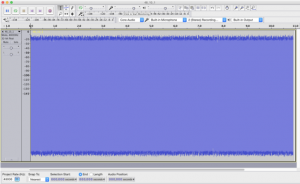
To Cut or Fade Out from 20 seconds, with the "I-bar" selected, click, hold and drag to the right.

To Cut:
Leaving the last 1.8 seconds selected, hit 'Delete'.
To Fade:
Leaving the last 1.8 seconds selected, pull down from 'Effects menu' (at top) to 'Fade Out'
Click Command-A to select the entire track
To quickly add channels of the same modified sound:
Click “Command-D” three times to create 8 channels while the track is selected.
Click "X" in upper left corner of any track to eliminate one track.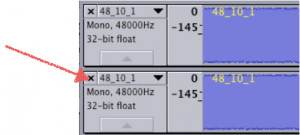
Good practice, absolutely recommended since it will help save you from confusion later in the process, though not mandatory:
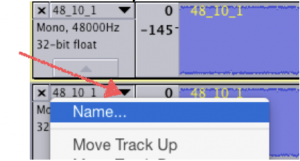
Name the channel by pulling down the box to the right of the 'x'.
Note: The fourth channel will always be the LFE channel.
7) To Sequence one track after the other
Click Cmd-A to select all the tracks.
Pull down the menu "Tracks" to "Align Tracks" to "Align End to End"
'Click Cmd-F' and 'Shift-Cmd-F' to get the entire set of tracks in the window.
Slip/Adjust tracks as desired.
8) To Export to broadcast WAV file (.wav) – for use as DCP
Pull down 'File' to 'Export Audio'. (Cmd-Shift-E)
Name file as desired, but definitely change the name or directory.
In 'Format' pull down to 'Other uncompressed files'.
Click 'Options';Select 'Header: WAV (Microsoft)'; Encoding: 'Signed 24 bit PCM'; Click 'Save'
9) To make channels Rotate…and LFE play last (See N.B. following Technique)
In Advanced Mixing Options: Click the 2nd box down on left. It will get a red outline
Click 'Channel: 3' on right side. A connection will appear.
Click 'Channel: 2' on right side. Connect it to 3rd box down on left side.
Click on connection bar between 3rd box on both sides to remove it.
Do the same to swap RtSurr and LftSurr for Channels 5 and 6.
If you’re looking for real fun, work with 8 channels. Drag the Output Channels out to 16, and place the Left Rear tone into Channel 11, and the Right Rear into Channel 12.
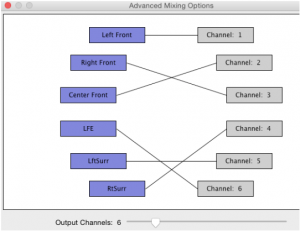
Click ‘Save’. The Next panel asks for metadata which is not supported in .wav files – so spend your time filling it in or just Click ‘OK'
NB: This technique only works if all channels have identical signals! If, for example, the LFE channel were increased by 10 dB before the Export, following the above Export example will create a Right Surround that is 10 dB too hot.
There are other techniques to make the same thing happen – and eventually (or now) you can learn. Basically, you will have to learn how to grab an audio portion of a track and move it around to the place you want it to be. This will become 2nd nature if you use the program enough, but is beyond the scope of this article.
10) Verifying the .wave file
Go to /pink_noise folder and open new file in Audacity using the “Open As…” technique described previously. If you merely double-click on the .wav file, iTunes will likely import it and play it for you.
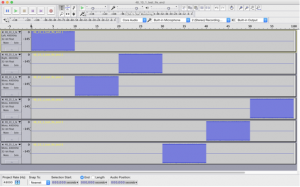
This is what it should look like when complete. It will play out L, C, R, RtSurr, LftSurr, LFE
Now that the .wav file is open, filters can be applied or levels can be adjusted.
11) To add or subtract level to a channel
You might decide that you want more or less level to the surrounds or LFE tracks. This is not difficult, but you want to only increase or decrease the signal, not amplify the silence around it.
Select – carefully select – the audio portion of the track – in some circumstances you can double-click on the then pull down ‘Effects’ to ‘Amplify’, then put in the number of dB to add (or -dB to subtract).
Do your best not to amplify the silence. But it is possible that you will not be able to avoid ‘grabbing’ a small portion of it.
You must export again to create a .wav file. When you “Save” in Audacity, you are creating an Audacity specific file set, not a playable .wav file.
But if you already have saved the .wav file so it plays channels in the proper order, then you don’t need to swap them on export again.
There is more potential in using the Audacity program, but this should serve the basic needs.
Please send document corrections or suggestions via the Contact Form. Thanks.